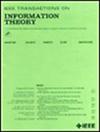纠正两次编辑的二进制代码
IF 2.2
3区 计算机科学
Q3 COMPUTER SCIENCE, INFORMATION SYSTEMS
引用次数: 0
摘要
编辑指的是一次插入、删除或替换。本文旨在构建可纠正两次编辑的二进制代码。要做到这一点,本文提供了一个代码可进行两次编辑校正的必要条件和充分条件,表明当且仅当一个代码可以分别校正两次删除和最多两次替换,以及一次删除和最多一次替换时,它就是一个可进行两次编辑校正的代码。根据这一标准,我们可以利用这三种纠错码构建双编辑纠错码。在构造用于纠正两次删除的编码领域,我们提出了一种具有 $4\log n+O(\log \log n)$ 冗余比特的构造,它可以被看作是 Guruswami 和 Håstad 提出的子编码,并提供了另一种证明。此外,我们的双删除校正码在稍作修改后也可以校正最多两个替换。在构造用于纠正一个删除和最多一个替换的代码领域,我们提出了一种冗余比特为 $4 \log n+O(\log \log n)$ 的构造,它优于之前已知的最佳结果 $6 \log n+O(1)$ 。利用这些编码,我们得到了一种冗余比特为 $6 \log n+O(\log \log n)$ 的双校正编码结构。这优于之前已知的最佳结果,后者至少需要 $8\log n$ 的冗余比特。此外,我们还考虑了双编辑信道下的列表解码问题,并构造了一种列表大小为 2 的双编辑列表可解码代码,其冗余比特为 $4 \log n+O(\log \log n)$ 。本文章由计算机程序翻译,如有差异,请以英文原文为准。
Binary Codes for Correcting Two Edits
An edit refers to a single insertion, deletion, or substitution. This paper aims to construct binary codes that can correct two edits. To do this, a necessary and sufficient condition for a code to be two-edit correctable is provided, showing that a code is a two-edit correcting code if and only if it can correct two deletions, up to two substitutions, and one deletion and up to one substitution, separately. This criterion allows for the construction of two-edit correcting codes leveraging these three types of error correcting codes. In the field of constructing codes for correcting two deletions, we present a construction with
$4\log n+O(\log \log n)$
redundant bits that can be viewed as a subcode proposed by Guruswami and Håstad, and provide an alternative proof. Moreover, our two-deletion correcting codes can also correct up to two substitutions after making a slight modification. In the field of constructing codes for correcting one deletion and up to one substitution, we present a construction with
$4 \log n+O(\log \log n)$
redundant bits, which outperforms the best previously known results
$6 \log n+O(1)$
. Leveraging these codes, we obtain a construction of two-edit correcting codes with
$6 \log n+O(\log \log n)$
redundant bits. This outperforms the best previously known result, which requires at least
$8\log n$
redundant bits. Moreover, we also consider the list-decoding problem under the two-edit channel and construct a two-edit list-decodable code with a list size of two employing
$4 \log n+O(\log \log n)$
redundant bits.
求助全文
通过发布文献求助,成功后即可免费获取论文全文。
去求助
来源期刊

IEEE Transactions on Information Theory
工程技术-工程:电子与电气
CiteScore
5.70
自引率
20.00%
发文量
514
审稿时长
12 months
期刊介绍:
The IEEE Transactions on Information Theory is a journal that publishes theoretical and experimental papers concerned with the transmission, processing, and utilization of information. The boundaries of acceptable subject matter are intentionally not sharply delimited. Rather, it is hoped that as the focus of research activity changes, a flexible policy will permit this Transactions to follow suit. Current appropriate topics are best reflected by recent Tables of Contents; they are summarized in the titles of editorial areas that appear on the inside front cover.
 求助内容:
求助内容: 应助结果提醒方式:
应助结果提醒方式:


